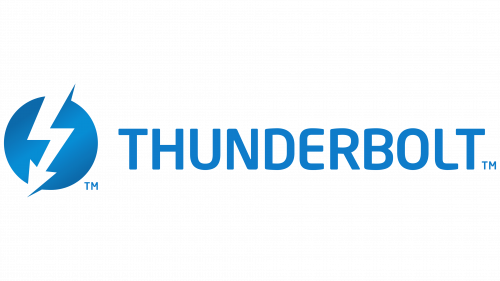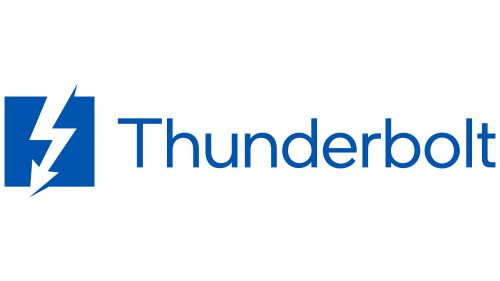The Thunderbolt logo conveys the idea of unity between the name and the image, creating a powerful visual representation. The emblem’s symbolism perfectly reflects the ease of data transfer and incredible speed inherent in the technology. This design emphasizes that recording and transferring information has become faster thanks to the brand’s technology, significantly increasing data transfer speed. The entire visual symbol captures the core characteristics of the technology, making it an essential part of modern digital solutions.
Thunderbolt: Brand overview
Thunderbolt’s history began in 2009 when Intel started working on a technology code-named Light Peak—the project aimed to create a high-speed data transmission interface for various devices.
Intel showcased early iterations of the technology at the Intel Developer Forum in 2010. Although fiber optic cables were initially planned, copper conductors were ultimately chosen to reduce production costs.
A significant milestone was reached in 2011 when the interface was officially introduced under Thunderbolt. Apple became the first company to adopt this standard with its MacBook Pro computers, and the initial version enabled data transfer rates of 10 Gbps per channel.
In 2012, Intel began actively promoting the technology to other computer manufacturers, releasing the first compatible peripherals, such as docking stations and external drives.
2013 Thunderbolt 2 was launched, doubling throughput to 20 Gbps through channel aggregation. This upgrade improved performance with high-speed devices and supported 4K video output.
A breakthrough came in 2015 with the third version, which adopted the USB Type-C connector and increased data transfer speeds to 40 Gbps. This change allowed a wider range of manufacturers to integrate the technology into their products.
Between 2016 and 2017, the third-generation technology gained widespread adoption, with many laptop and accessory manufacturers incorporating it into their products. Intel also introduced a certification program for compatible devices.
In 2019, Intel released the fourth specification, introducing stricter performance and security requirements while maintaining a 40 Gbps data transfer rate.
The widespread rollout of Thunderbolt 4 began in 2020, offering improved data security and enhanced support for multiple displays. Through 2021 and 2022, the ecosystem continued to grow, with more compatible devices and accessories hitting the market. Intel also worked to improve compatibility with USB4 and other standards.
The interface has consistently enhanced connectivity options throughout its development and expanded its feature set. What began as an experimental optical interface evolved into a globally adopted high-speed connection standard.
Adaptability to market needs has been key to its success. The transition to the USB Type-C connector and compatibility with USB4 have made this technology more accessible and universal while maintaining high performance and reliability.
By 2023, it had become a leading standard for high-speed peripheral device connections, supported by most computer hardware manufacturers and continuously evolving to meet new technical requirements.
Meaning and History
What is Thunderbolt?
This powerful hardware interface technology allows multiple high-performance devices to connect through a single port, providing lightning-fast data transfer speeds and versatile connectivity options. By combining DisplayPort and PCIe protocols, the interface functions as a universal connector, enabling users to daisy-chain devices such as external monitors, storage drives, and docking stations, transmitting video, data, and power simultaneously. A unique feature is its ability to deliver professional-grade performance. It allows a wide range of devices—from 4K displays to high-speed storage drives—to connect through one compact port, offering high bandwidth and reliability.
2011 – 2023
The company’s emblem includes a visual symbol and the name on the right. All elements are designed with smooth and streamlined shapes. The round mark and the curves of the glyphs resemble wires, highlighting the service’s primary function—connecting various gadgets.
The wire’s cross-section depicts a lightning bolt, emphasizing near-instantaneous data transfer. This symbol harmoniously aligns with the brand’s name, creating a cohesive image of high-speed electrical impulses. The port can transfer up to 1.25 gigabytes of information per second, making it efficient.
The uppercase letters in the name highlight the technology’s potential and capabilities: up to six devices can be connected simultaneously through a single port, offering vast possibilities for use.
2023 – today
With the release of the fifth modification, the logo was changed to reflect a breakthrough that will propel the company far ahead, leaving competitors behind. The name now starts with a capital letter, while the remaining characters are in lowercase. The glyphs are thinner compared to previous versions, highlighting efficiency and using minimal resources for operation.
The circular shape of the symbol was replaced with a square, creating an association with a computer monitor or data storage space. The high transfer speed supports large storage devices, transmitting up to 20 gigabytes per second, and for 8K monitors—up to 30 gigabytes per second. This makes the port the fastest in its class, emphasized by the white lightning bolt cutting through the square symbol.
The Thunderbolt logo represents advanced technology and underscores the portal’s capability to operate at maximum performance, conveying confidence in its future success.






